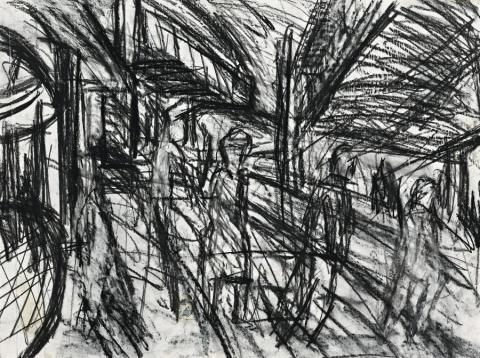OUTSIDE KILBURN UNDERGROUND NO.4, c.1979
LEON KOSSOFF
charcoal on paper
56.0 x 75.0 cm
Fischer Fine Art, London
Jeffrey Makin, Melbourne
Rex Irwin Art Dealer, Sydney (label attached verso)
Private collection, Sydney, acquired from the above in 1988
Leon Kossoff : paintings and drawings, 1974–1979, Fischer Fine Art, London, May – June 1979
Important Works on Paper, Rex Irwin Art Dealer, Sydney, 1988
Like all things about Leon Kossoff's life, his infatuation with Kilburn Underground Station is both simple and complex. 'It's near me. It's interesting. And I like drawing there',1 he says. Kilburn is a suburb of North West London and the underground is on the Jubilee line. Like Kossoff, I used to live about five minutes' walk from it, and can testify to its ebb and flow of commuters, and its rattle and rush of trains, entering and exiting this outpost of the metropolis.
The Tate Gallery, London has an encyclopaedic collection of his drawings and paintings depicting both the interior and exterior of this station. According to Kossoff, 'I have done many, many drawings of the subject; I couldn't possibly enumerate.'2 The Tate's researchers, however, are paid to do just that, and the list they have come up with is long and detailed (the prints alone go up to at least twelve states and give a fascinating insight into how his vision of the subject as a whole evolved over many years). The exterior drawings, for example, are always seen from the left hand side of Christchurch Avenue, looking towards Kilburn High Road.
When Kossoff exhibited in the British Pavilion at the Venice Biennale in 1995 the catalogue pointed out that his forensic examination of the London he knows and loves was given added impetus several years earlier by 'the Thatcher government's rebuilding of East London with slogans such as: CANARY WHARF, IT WILL FEEL LIKE VENICE AND WORK LIKE NEW YORK.'3
Kossoff is five years older than his friend Frank Auerbach, who himself exhibited in Venice in 1986. Their early lives and their later painting techniques frequently mirror each other, and they both acknowledged a huge debt to their inspirational teacher David Bomberg, part of what's known today as the Slade Art School's 'crisis of brilliance'.
'Ever since the age of twelve I have drawn and painted London', Kossof says.'The strange ever-changing light, the endless streets, and the shuddering feel of the sprawling city linger in my mind like a faintly glimmering memory of a long-forgotten, perhaps never-experienced childhood, which, if rediscovered and illuminated, would ameliorate the pain of the present.'4
This archetypal drawing of Kossoff's has a top layer that is executed with speed and precision. It is both confident and bursting with energy. Yet, as he says,'The truth is that all my life I've been filled with self-doubt.'5; And it is this life-enhancing doubt that is the scaffolding underpinning this drawing and supporting its final resolution. Like Auerbach, palimpsest is built upon palimpsest in these drawings, like a house of cards that is continually built up and then demolished.
'Just imagine', writes Michael Glover, 'the sight of his finger ends. He used to draw and paint in a mood akin to frenzy, with ferocious slashings and wrigglings of marks. The colours were most often sombre - greys edging off to black. He has always loved architectural decrepitude, often seen from a fairly high view point: gantries; a gasometer; the demolition site; conventionally unlovely industrial locations; places between places; grubby edgelands.'6
Kossoff, the son of a Jewish baker, and now 87 years old, is a small, intense man with white hair and blue chip eyes. His last exhibition travelled from London to Paris, New York, and California. Jackie Wullschlager, the well-travelled art critic for The Financial Times, described it as 'the most enthralling exhibition I have seen this year'.7
1. The Tate Gallery 1984-86: Illustrated Catalogue of Acquisitions Including Supplement to Catalogue of Acquisitions 1982-84, Tate Gallery, London, 1988, pp. 397-399
2. Ibid.
3. Overton T., Leon Kossoff, Venice Biennale Group Show, British Council website, London, 1995, <http://venicebiennale.britishcouncil.org/people/reference/leon-kossof>
4. Ibid.
5. Wullschlager, J.,'Coming Home', The Financial Times, London, 3 May 2013, p. 23
6. Glover, M. The Independent, Tuesday 14 May 2013, p. 24
7. Wullschlager, J., op. cit., p. 23
DR PETER HILL
